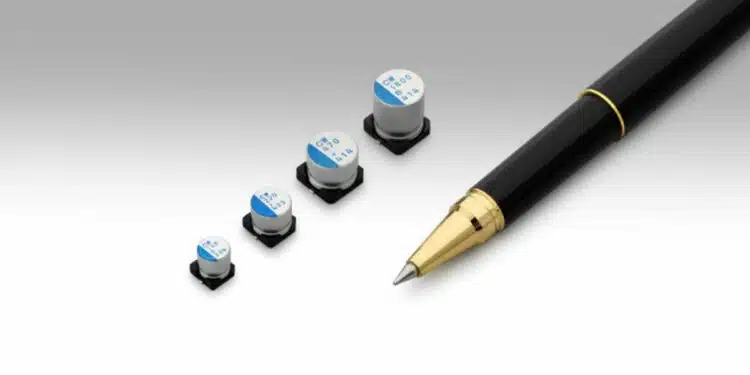NICHICON CORPORATION has expanded the rated capacitance of the PCW series of chip-type conductive polymer aluminum solid electrolytic capacitors with a guaranteed superimposed ripple current at high temperatures, to meet the increasing demand in the automotive and telecommunications fields.
The PCW series is the industry’s first conductive polymer aluminum solid electrolytic capacitor with a guaranteed superimposed ripple current. The expanded rated capacitance values will contribute to circuit board designs that require high temperature compatibility.
Overview and Development Background
Many low-voltage circuits using PMICs or CPUs/GPUs are being installed in automotive circuits, which have become increasingly more electrified. To meet increasing demand NICHICON launched in 2022 the PCW series.
The PCW series is the industry’s first chip-type conductive polymer aluminum solid electrolytic capacitors with a superimposed ripple current guaranteed at 125°C for 2,000 hours. This allows the PCW to satisfy the needs for high-temperature tolerance and high reliability.
NICHICON has now added φ8×7L and φ8×10L sizes to the existing product lineup, expanding the rated capacitance from 390μF to 1800μF. This expansion in sizes enables Nichicon to offer a wide range of products for various applications that require high capacitance and high ripple current while contributing to further performance enhancement and optimization of set devices.
Features
Conductive polymer aluminum solid electrolytic capacitors are products that use only conductive polymers as the electrolyte. They feature low ESR performance and high heat resistance as well as an extremely small decrease in capacitance over time due to the absence of an electrolytic solution.
The PCW series employs highly heat-resistant sealing rubber to maintain stability even at high temperatures while achieving low ESR and reduced self-heating by using a superior lead wire and other optimized materials.
Further, the series is the industry’s first conductive type capacitors to guarantee superimposed ripple current and high ripple current, contributing to circuits that require high ripple current in low-voltage ranges.
NICHICON has now expanded the PCW series by adding the new sizes of φ8×7L and φ8×10L to the existing sizes of φ5×6L and φ6.3×6L, expanding the rated capacitance from 390μF to 1800μF. The new high capacitance and high ripple currents will contribute to reducing the number of capacitors needed and reduce noise in circuit designs.
- Rated voltage range :2.5 to 6.3V
- Rated capacitance range :150 to 1800μF
- Category temperature range:-55 to 125℃
- Product dimensions :⌀5×6L to ⌀8×10L (⌀5×6.3L to ⌀6.3×6L Sizes are in mass production)
- Life :2,000 hours guaranteed at 125℃(Rated ripple current superimposed)































